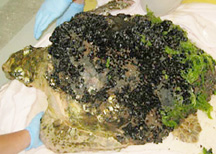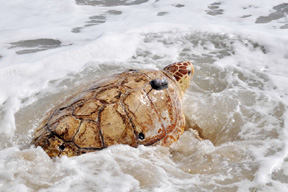
 Trees May Be Priceless . . .
Trees May Be Priceless . . .
But each one you plant can earn you $25
Can’t see the forest for the lack of trees? The state of Maryland will give you a $25 coupon for the purchase of a tree. Or two. Or more.
The $25 coupons encourage citizens to plant 50,000 trees this year as part of Marylanders Plant Trees, Gov. Martin O’Malley’s campaign to reforest the state with one million new trees by 2011.
The program’s website — www.trees.maryland.gov — lists eligible trees, where to buy them and get your coupons, along with tips on how to place and plant them. You’re then asked to register your trees online, site them on the interactive map and calculate the benefits from the planting. Register your planting, and you’ll be entered in a monthly prize drawing.
“In addition to protecting water quality, cleaning our air and providing wildlife habitat, one large tree can eliminate 5,000 gallons of storm water runoff annually,” O’Malley says. “And well-placed trees can help reduce energy costs by 15 to 35 percent.”
By mid-September, 16,930 trees were planted and registered.
The program’s $480,000 funding comes from a $4.6 billion settlement by a major power generator for Clean Air Act violations. Under an agreement with the attorney general and Maryland Department of the Environment, income from the settlement must be used for environmental projects — like tree planting — that benefit air quality.
The state reimburses the businesses $20 for each coupon redeemed; the businesses underwrite the additional $5.
Participating local nurseries:
In Anne Arundel County, Greenstreet Gardens in Lothian; Homestead Gardens in Davidsonville; Evergreen Gene’s Garden Center in Glen Burnie.
In Calvert County, Farm Valley Nursery in Huntingtown; Kelly’s Nursery in Dunkirk; Wentworth Nursery in Prince Frederick.
–Margaret Tearman

Elizabeth Weible, President of Friends of Anne Arundel County Trails, and her dog, Misty, County Executive John R. Leopold; Animal Welfare Council Chairman Wendy Cozzone and her dogs, Bell and Cheryl; and Chris Carroll, Chief of Park Operations South, dedicate the first of the 25 Pet Waste Stations along the B&A Trail.
|
 Pet Waste Stations Make B&A Trail Safer to Walk
Pet Waste Stations Make B&A Trail Safer to Walk
And neighboring creeks cleaner
Dog walkers along the B&A Trail have no excuse to fail to pick up the dropping their pets leave behind. Anne Arundel County installed 25 Pet Waste Stations along the trail in hopes of curbing a nuisance to the enjoyment of the trail and the health of the Chesapeake ecosystem. Pull a bag from the green plastic baggie dispenser, and you’re gloved for pick up.
The problem isn’t only aesthetic. Pet droppings wash potentially sickness-carrying bacteria, including E. coli, salmonella and shigella, into waterways. Three of the major waterways crossed by the trail — Rock Creek, Marley Creek and Furnace Creek — have been closed at times due to waste pollution. Maryland Department of the Environment and Salisbury University researchers found that animal waste filled waterways with dangerous enterococci bacteria. The top polluters according to the study were wildlife, followed by dogs, humans and livestock.
The study found that two-thirds of the bacteria in Furnace and Marley creeks came from the waste of foxes, deer and dogs.
September 18, County Executive John R. Leopold unveiled the first of the 25 Pet Waste Stations along the trail and encouraged communities to install their own. The stations will cost about $1,000, but funds could be recouped through the county’s Lasting Memories Program. If you memorialize your pet with a plaque at a waste station, Fido will be able to leave his mark on the trail permanently — without harming the watershed.
–Diana Beechener
Pictures from Home
Local photos bound to ease the homesick blues of deployed Calvert countians
With photos from the neighborhood, Calvert County hopes to ease the homesick blues in the hearts of countians serving far from home with the military.
Citizen photographers sent hundreds of images to this year’s Focus on Calvert photo contest. They depict life in Calvert County, landmarks, familiar landscapes and Calvert countians — including some local dogs — enjoying it all. Now they’ve all been collected on a CD that the Board of County Commissioners hopes will shorten the distance between duty and home.
“A lot of us know people who are deployed,” says County Commissioner Susan Shaw. “Like [her former neighbor] sailor James Granlund, whose deployment was just extended from two to three years. He only gets to come home to Port Republic once a year to see his wife and two small children. We feel for these soldiers.”
With no idea how many county residents are deployed, the commissioners are asking your help in identifying far-flung family and neighbors in active service.
Email names and addresses to [email protected]. The photo CD will include a letter of thanks for the receiver’s service and courage.
–Margaret Tearman
Our Hapless Neighbors
Feeling crabby
Cases and cans of jumbo lump crabmeat came raining down on northbound drivers on a northern Anne Arundel stretch of I-97 in the early morning hours of September 14. Half the 137 cases of the delicacy were spilled when a delivery truck from Little River Seafood, in Virginia’s Northern Neck, was cut off as it approached Baltimore.
Out of control, the 2006 Nissan box truck struck the guardrail before flipping three times. It took a Jaws of Life to extricate the driver, 83-year-old William Hudnall, who was medivaced to Maryland’s Shock Trauma Center.
–From Maryland State Police Reports
This Week’s Creature Feature
One loggerhead turtle back in her element
 When this loggerhead sea turtle was found last July in an Ocean City inlet, it was covered in 10 pounds of barnacles, mussels and sea grasses, left. More than a year later, the turtle was healed, had gained 26 pounds and was returned to the waters off Assateague State Park. When this loggerhead sea turtle was found last July in an Ocean City inlet, it was covered in 10 pounds of barnacles, mussels and sea grasses, left. More than a year later, the turtle was healed, had gained 26 pounds and was returned to the waters off Assateague State Park.
|
 |
 A sad story reached a happy ending on September 19, when a rehabilitated loggerhead sea turtle returned to sea — to the cheers of some 500 well-wishers on the beach at Assateague State Park. The 90-pound turtle paddled avidly into her native element after 113 days of emergency care and rehabilitation in Baltimore at the National Aquarium’s Marine Animal Rescue Program.
A sad story reached a happy ending on September 19, when a rehabilitated loggerhead sea turtle returned to sea — to the cheers of some 500 well-wishers on the beach at Assateague State Park. The 90-pound turtle paddled avidly into her native element after 113 days of emergency care and rehabilitation in Baltimore at the National Aquarium’s Marine Animal Rescue Program.
The glistening brown-and-tan shell of the young adult — likely a sexually immature female — was marred only by a satellite tag and a few scars. That’s a far different picture from when the turtle was found last July, floating in an Ocean City inlet and unable to dive to feed or avoid boat traffic. Then 10 pounds of marine creatures — barnacles, blue mussels and sea grasses — infested and penetrated her shell.
Over the year of captivity, the turtle feasted on enough squid and blue crab, her species’ favorite food, to gain 26 pounds. The deep-shell infections were treated with antibiotics and their healing monitored with CT scans administered by the radiology staff at John’s Hopkins Hospital.
She is the 82nd animal released by the National Aquarium since 1991. Staffed almost entirely by volunteers, the Marine Animal Rescue Program has responded to hundreds of strandings, including seals, dolphins and endangered sea turtles, and to sightings of manatees, dolphins and other marine mammals.
“All sea turtle species are at risk of being wiped out completely, and so the rehabilitation and release of even one individual turtle helps to keep the species viable,” according to Stranding Coordinator Jennifer Dittmar. Loggerheads, one of six species of sea turtle in U.S. waters, are classified as threatened under the Endangered Species Act.
“When this loggerhead came to us it was unlikely to survive, much less continue to propagate,” Dittmar said. “Now that it is healthy, we have every reason to believe that it will be successful in its natural environment.”
The turtle seems intent on proving Dittmar right. In two days, she’d traveled 331⁄2 miles, from south of Berlin to south of Chincoteague.
Funded by the Shared Earth Foundation, the transmitter glued to her shell sends back information about her progress, location and speed. Follow her on satellite map at http://www.aqua.org/trackflightand release.html.

